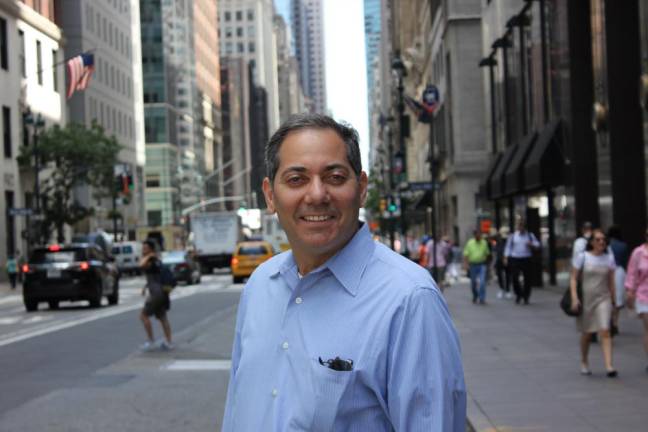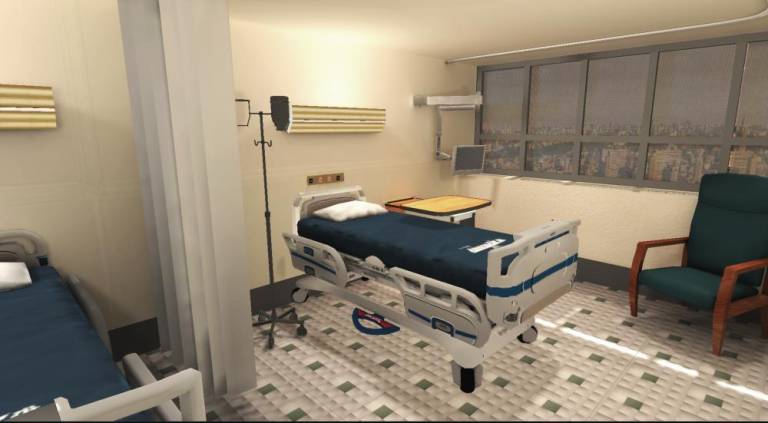Virtual Reality Comes to a Hospital Close to Home
Founder and CEO of a local virtual reality company affects change in NYU Langone’s protocol


When Lyron Bentovim was exploring the virtual reality arena in New York, he did a simple Google search which ultimately ended up changing the course of his career. As fate would have it, he happened upon a Meetup group that was taking place in an hour. What he could have never imagined at the time was the moderator of that group would later become the cofounder of the business that he was looking to create.
The serendipitous New York origin story of The Glimpse Group, a virtual and augmented reality company, shows the power of connections in our city that go on to have global implications. After launching in 2016, Glimpse has grown exponentially, now partnering with organizations in diverse fields — from hospitals like Montefiore and Mount Sinai and technology companies such as Google and Snap, to retailers like Panera and Dominoes and universities such as Fordham and Temple. “A host of real names that are all exploring, dipping their foot in the water, and we’re trying to be their partner in exploring how to do certain things in VR and grow with them,” Bentovim, a native of Israel, explained.
A Glimpse partnership with Bayer Pharmaceuticals led to a meeting with an executive at NYU Langone, who was impressed with their technology, which she thought could solve a problem the hospital system was having with their training of new janitorial staff, specifically in the proper sanitizing of rooms between patients. The challenges they faced included the facts that the position tends to have a high turnover rate and for many of the employees, English is not their first language, which resulted in senior staff spending a lot of valuable time explaining the cleaning process.
That is where Bentovim’s company, whose office is based near Bryant Park, came in with their virtual reality training program. They recreated a Langone hospital room as well as all the steps involved, which not only teaches employees, but also tracks their progress during training, so management can decide when they’re prepared to put their training into action and clean an actual room.
Tell us how the idea for Glimpse came about.
I’ve been a student of technology cycles and I grew up in the ‘80s tech cycle, which is PC, mobile and internet. Seeing how the cycle evolves from innovations of infrastructure and hardware and then essentially becoming a software-led cycle. Those cycles are 35 years, give or take. In 2016, I looked at virtual reality, augmented reality and artificial intelligence. And it felt like we were like the early ‘80s of that previous cycle with these technologies. And I thought that would be a great opportunity to come in early. The easiest thing was to find a company that needed someone to lead it or start a company solving something in that space. The challenge in early technology cycles is that there are not a lot of customers. There’s a disconnect between the investment money coming in and the execution of the business in the early part of a tech cycle. That disconnect causes a lot of companies to fail. Because you raise money thinking you’re going to build something and you build it, but because of the early nature of the technology, buyers are not always there and the investors can’t distinguish between being early, you built a great product and users will come later, to being wrong, you built a product that is bad or not needed.
The second thing that was very unique about what I built at Glimpse is I learned that being an entrepreneur, especially in early stages of an industry, is a very lonely thing, the industry is in its infancy and there is not a lot of support for the entrepreneurs ... And you’re on your own sitting in a WeWork or garage somewhere. And I wanted to look at what was out there in terms of efficient models, whether it was incubators, accelerators, and trying to take the best out of those and create an environment that will allow entrepreneurs to be part of an ecosystem where they’re all in with each other.
Explain how you met your cofounder.
It’s funny because as I was looking at this industry, I was searching for what was happening in New York in the virtual reality scene. And I Googled “NY VR” and the first thing that popped up was NYVR, which is the Meetup that my now-cofounder, DJ [Smith] is running. I didn’t know DJ and I didn’t know that NYVR existed. So I clicked on that, and as luck would have it, they had a meeting an hour from when I was doing the search. They were doing it once a month on Thursday evenings ... and that was exactly it. And I was talking to someone who basically was speaking to me about this opportunity and he was in New York, and I was sitting at home in New Jersey. I said, “It looks to be sold out, but can you just go there and see what’s going on and report back to me?” And so he went to the session and was texting me throughout, saying, “It’s amazing. This is happening. This is real.” Then I connected with DJ to go and have lunch the week after.
How did you partnership with Langone come about?
One of our clients a few years before was Bayer Pharmaceuticals and we did a couple of VR experiences for them. And the executive at Bayer that we were working with had a good friend who was someone pretty senior at Langone ... She came with him and we demoed some of our technology and she was very impressed. They were really interested in this opportunity because they had real problems that VR could address. Closing deals with organizations like Langone takes a while, so it was a long process.
Explain the VR program you created for them.
If you look at hospital rooms, always in between patients, you need to clean them. So that’s clearly a very, very important task. But it’s done by janitorials, which is not a long-term position. So there’s a lot of turnover in that position, and many of the people that are coming in are not necessarily fluent English speakers. So you have something that’s very, very important that is done by people that have very high turnover. And the challenge is how do you teach them how to do it right. And Langone has their own way of how to clean a room between patients. They have an eight-step process and it’s very complicated. And so how can you teach them? Every time you need to do that, you need to have someone senior take a lot of their time explaining how to clean a room, showing them and then seeing that they’re doing it right and then sometimes there’s a language barrier. And at the end of the day, that person will then move on after a few months and then you have to do it over and over again. So they find it to be very challenging and very expensive.
What has feedback been like from hospital employees?
They loved it. One of the most rewarding things is to see a professional do it in there. Being in VR is cool when you’re inside, but when you’re outside, watching people do VR is so fun. You see people that have the headset on and they’re using their hands and stuff and doing all the motions like they’re actually cleaning. The human beings demoed it in our demo area, which is outside of my office, and I would sit there and watch all of them virtually cleaning and it was very funny. But when we gave the product to Langone, seeing the pros doing the cleaning was so powerful.
www.theglimpsegroup.com